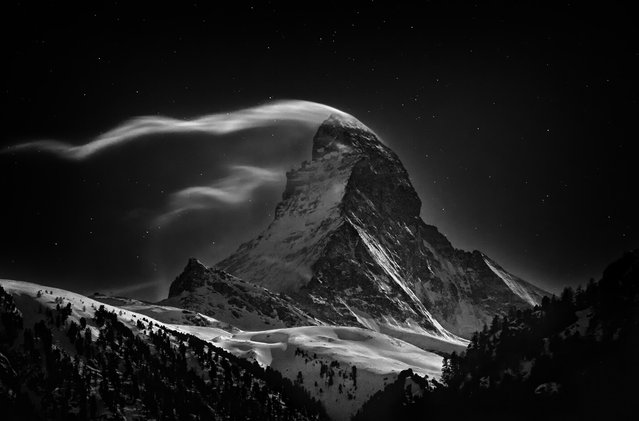
“The Matterhorn: Night Clouds #2 – The Matterhorn, 4478 m, at full moon”. (Photo and comment by Nenad Saljic/National Geographic Photo Contest via The Atlantic)
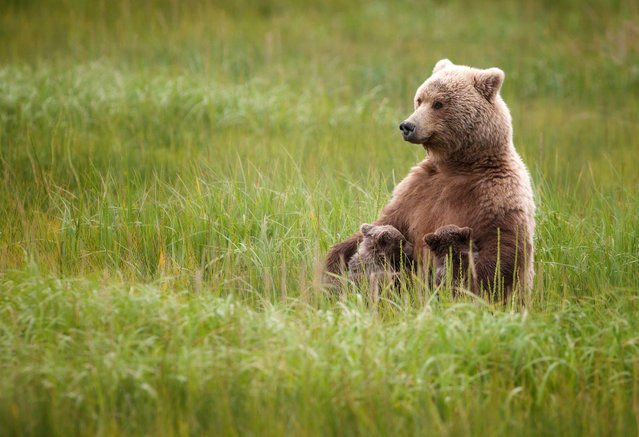
“Nursing Mama: This female brown bear came into the Lake Clark National Park area in late July with her triplet Spring cubs and seemed quite relaxed as she sat nursing two of her cubs”. (Photo and comment by Ruth Steck/National Geographic Photo Contest via The Atlantic)
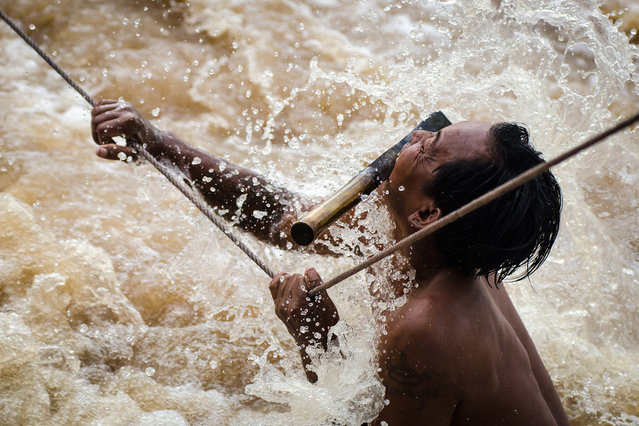
“Waterfall Fisherman of Si Phan Don: Around the turbulent waterfalls of Si Phan Don in Southern Laos a select few fisherman risk their lives daily to catch fish from the swollen Mekong River. The fisherman use small bamboo traps to catch migratory fish making their move through the falls. Here the fisherman holds on for his life knowing that one mistake here would result in certain death. The raging Mekong pulls at his body as his weary arms cling desperately to hold him on the rope. Times like these rely on full concentration and both hands on the rope at a time, any extra luggage has to go in the mouth, knives included”. (Photo and comment by Jacob James/National Geographic Photo Contest via The Atlantic)
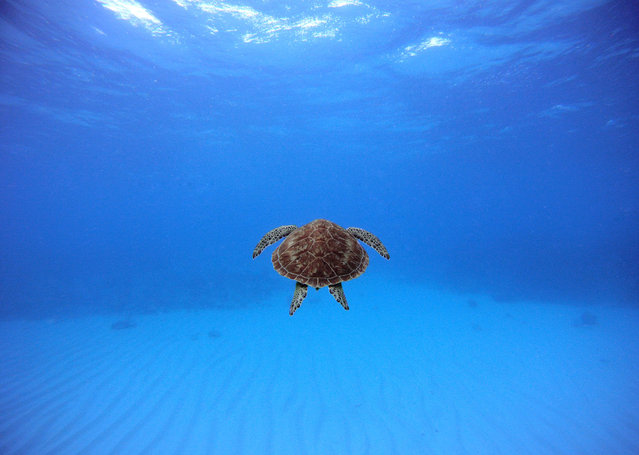
“Swimming with a Turtle: After observing this turtle, I swam with him for a few minutes”. (Photo and comment by John Peterson/National Geographic Photo Contest via The Atlantic)
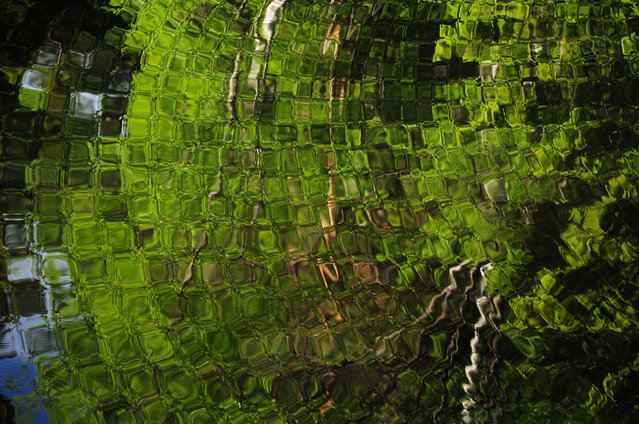
“Water Magic: In a world of a million water pictures, it's easy to dismiss this as “just another reflection shot”. Still, this unedited image proves how unreal water can behave under certain circumstances. Here I stand at the narrowest point of a small lake, and as usual I have thrown objects into the water to see how it behaves visually. Because the lake was so narrow, only a few meters, the circles start to recoil from land. The effect is called, to my knowledge, interference, but I have yet to see anything similar, even after all these years of throwing rocks into the water”. (Photo and comment by Jorgen Tharaldsen/National Geographic Photo Contest via The Atlantic)

“Libyan Rebel at the Old Shipyard of Benghazi: During the Libyan revolt against Moammar Qaddafi, the city of Benghazi was liberated early on, and became the base for the rebels and the transitional governing body. Armed rebels were seen all over the place. Many of them had no previous war experience but joined the revolt willingly to get rid of the regime. This rebel, with his spick & span boots and outfit, was guarding the old shipyard”. (Photo and comment by Mohannad Khatib/National Geographic Photo Contest via The Atlantic)
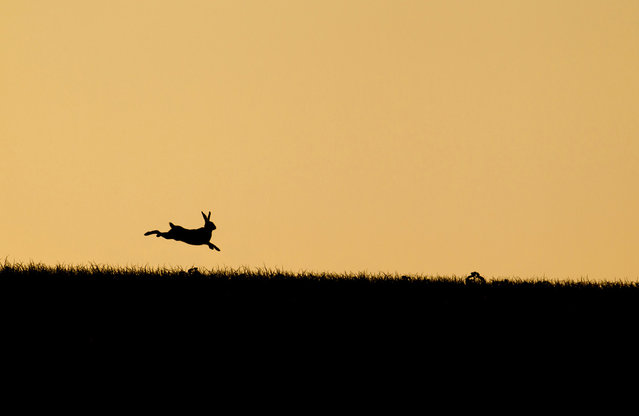
“Leaping Hare at Sunset: For a couple of weeks a year the sun sets over this hill near where I live. I knew the field was favored by a few hares and had previously photographed them on this ridge with the sun setting behind. For this particular image I had been tracking this individual hare as it wandered along the ridge and was set up to capture it as it leaped in the air”. (Photo and comment by Kevin Sawford/National Geographic Photo Contest via The Atlantic)
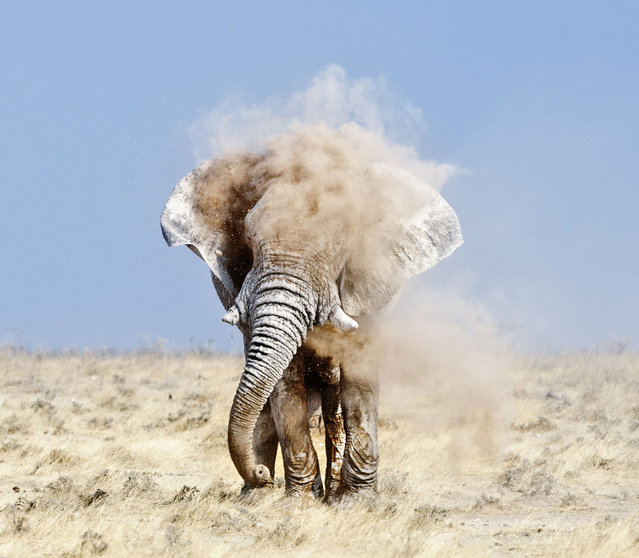
“The Godfather: He is big – 4 meters tall and over 4 tons in weight. He is the “Godfather”. I have visualized this scene many times. I have checked and rechecked my equipment and decided upon the camera and lens combination. I now relax and control my breathing as they come in to view. The next ten minutes are a bliss of forgetfulness as I zone in to the task at hand; only one moment stands out. He stands still before me in all his magnificence, raising his trunk filled with the red Kalahari dust. In one fluid movement he sprays his forehead and for one brief moment he is covered in the magic of dust and light”. (Photo and comment by Peter Delaney/National Geographic Photo Contest via The Atlantic)
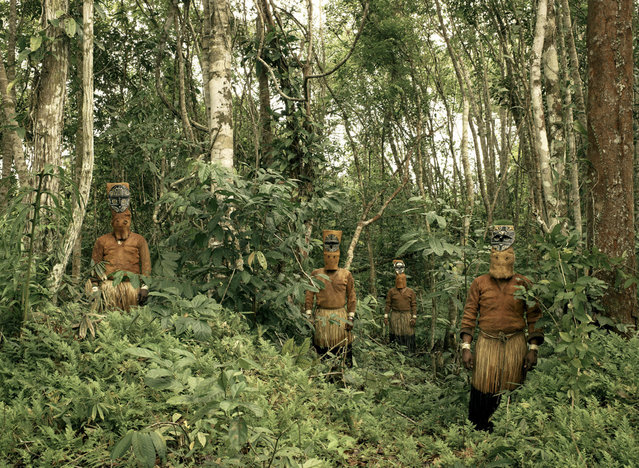
“Guardians of the Forest: Deep in the Colombian Amazon, Yucuna indians stand dressed in traditional tribal attire for the Baile del Muñeco, or puppet dance, a celebration of the abundance of the Chontaduro fruit. While traditional indigenous customs are fast being lost throughout the Amazon jungle, here, far down the Caqueta river and few miles from the Brazilian border, traditions are still very much intact. The costumes are still made entirely from natural materials, predominantly tree bark, during this three day festival”. (Photo and comment by Piers Calvert/National Geographic Photo Contest via The Atlantic)

“Charging Black Drongo: The Black Drongo selects a good perch near a water body, and takes off when an insect is sighted on the surface, skimming across the water and back to its perch. I spent almost 10 days (1 hr daily morning – sitting quietly and motionless) and on October 25, 2012, this was clicked. I was lucky to get this just before any skimming action started. I like the concentration level in its eyes, wing position and wide open mouth ready to catch the insect by surprise, and the same action in reflection”. (Photo and comment by Vinayak Parmar/National Geographic Photo Contest via The Atlantic)
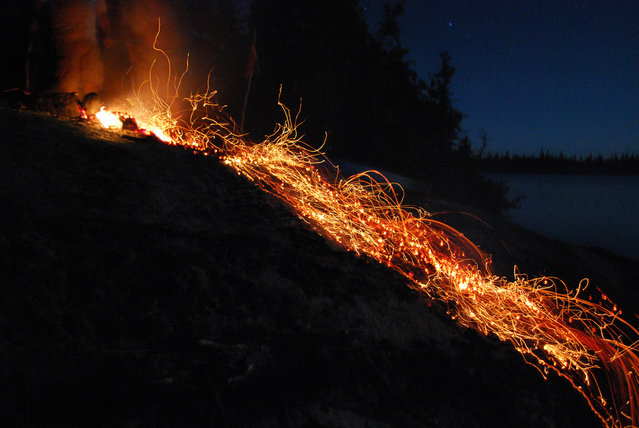
“Rolling Coals: I went on a kayaking camping trip with my best friend on a remote lake in NW Ontario, DeCourcey Lake. Staying on a little, rocky island we listened to the waves, and watched the stars, sitting by the fire. When it was time to put the fire out, my friend began kicking the coals down the rocky slope to the water below. I ran down to the waters edge to catch the motion of the burning coals. Little comets streaming to the lake to be extinguished with a hiss”. (Photo and comment by Christopher Merkley/National Geographic Photo Contest via The Atlantic)
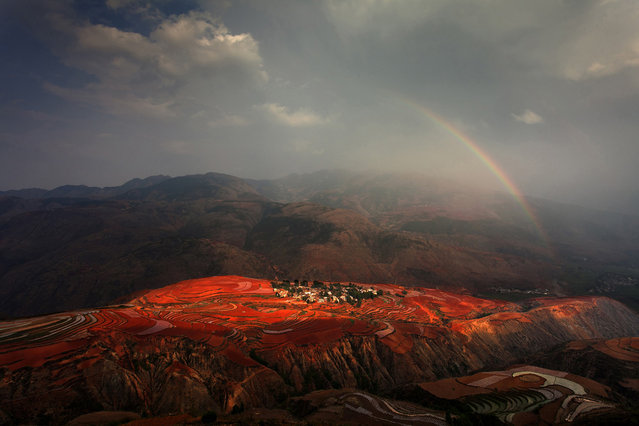
“Red Land: Sunset Cloud Village is one of the most picturesque places in Red Land, China. As its name indicates, it's best to see before sunset. The reddish brown soil turns redder after rainfall and after farmers plow the land”. (Photo and comment by Peng Jiang/National Geographic Photo Contest via The Atlantic)
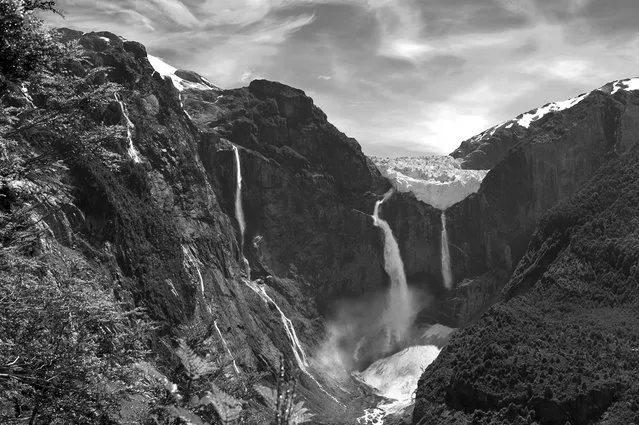
“Ventisquero Colgante Falls, Chile”. (Photo and comment by Dario Caballes/National Geographic Photo Contest via The Atlantic)
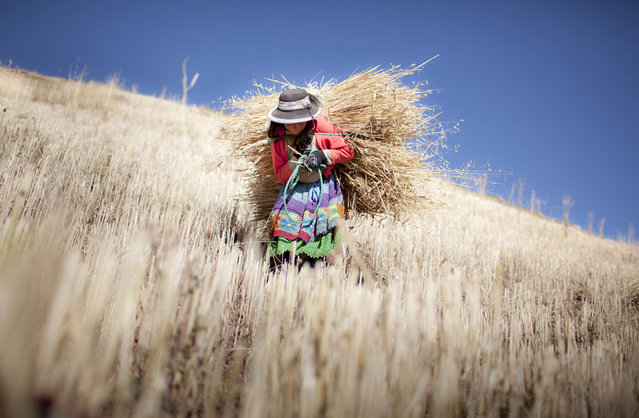
“Luzmila: Luzmila, 12 years old, carries to her house the barley that she harvested by herself on her family's little farm situated on the mountain behind their house in a rural village in the Andes Mountains called Sotopampa, in Peru. Once a year, they harvest the barley and then they consume it during the following year. In these communities of indigenous peoples, children work helping their families. It is very hard for the government to maintain a balance between child labor laws and the ancient traditions of these populations that include some difficult tasks for kids”. (Photo and comment by Alejandro Kirchuk/National Geographic Photo Contest via The Atlantic)
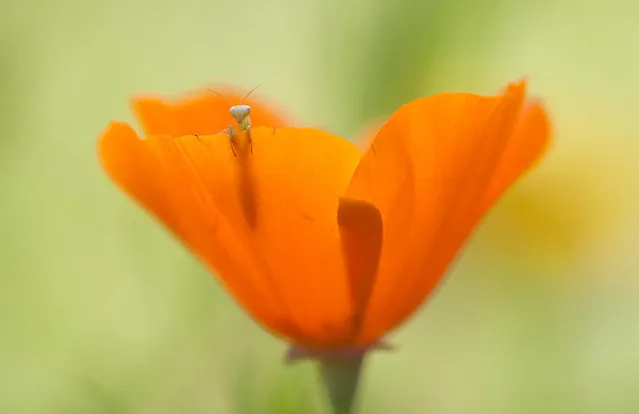
“Hello World!: A tiny mantis larva in an American poppy flower”. (Photo and comment by Fabien Bravin/National Geographic Photo Contest via The Atlantic)

“The Location: The iron and steel bars are located in their correct position. Perhaps it is not deliberately made by somebody, but naturally positioned unknowingly by the shop owner over time”. (Photo and comment by Noh Keun Park/National Geographic Photo Contest via The Atlantic)
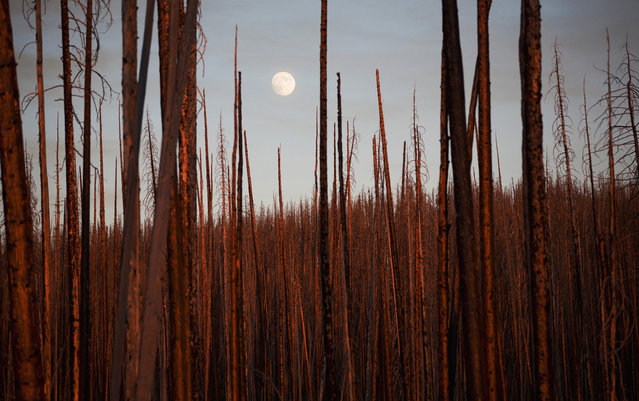
“Silence Voice: Sunset time, a peaceful burnt woods just surround you quietly. Together with your heart beating, you can feel the smooth breeze and hear the sounds of emerging exuberance underneath. The perfect ending is in the endless. The picture was taken in Yellowstone National Park. Turning themselves into such strong remainders, the woods have given hopes to their next generation through a wildfire”. (Photo and comment by Chaoying Zhao/National Geographic Photo Contest via The Atlantic)
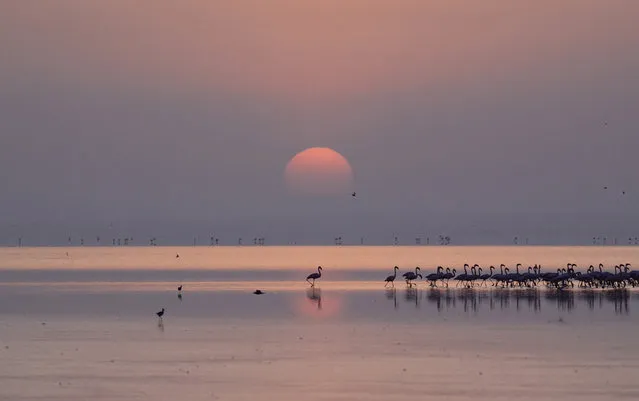
“Early Morning Sunrise Flamingo: Lake Manyara, Tanzania – early morning game drive”. (Photo and comment by Sheila Jones/National Geographic Photo Contest via The Atlantic)
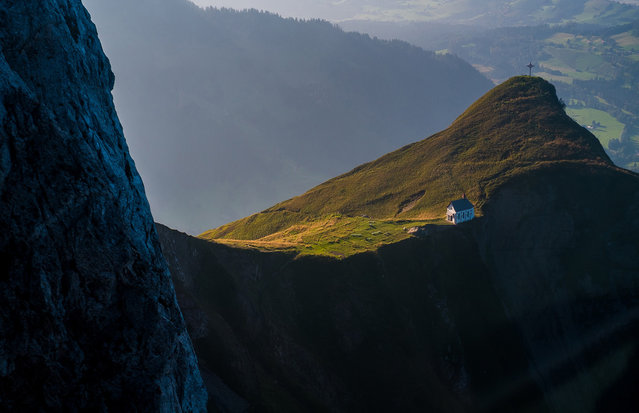
“Chapel on Klimsenhorn: I took this picture while I was in an aerial cableway going down from the Mt. Pilatus in Central Switzerland. It was the end of a nice day spent hiking, including a stop by the beautiful little white chapel on Klimsenhorn on the way to the top”. (Photo and comment by Agne Subelyte/National Geographic Photo Contest via The Atlantic)
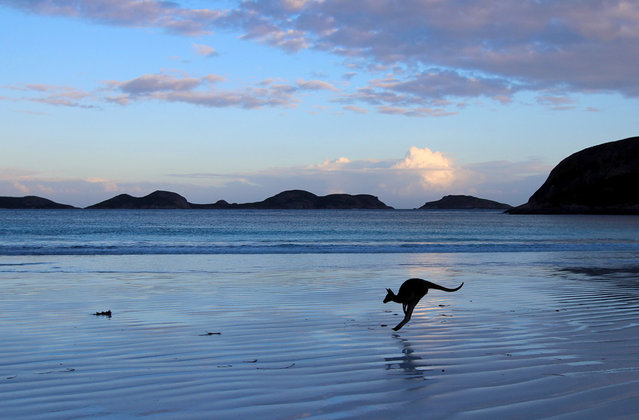
“Lucky Bay: Beautiful Lucky Bay in Esperance, Western Australia, is home to many kangaroos. Not only is the turquoise water and white sand a sight to see but at sunset the kangaroos bounce their way across the sand looking for dinner”. (Photo and comment by Mandy Wilson/National Geographic Photo Contest via The Atlantic)
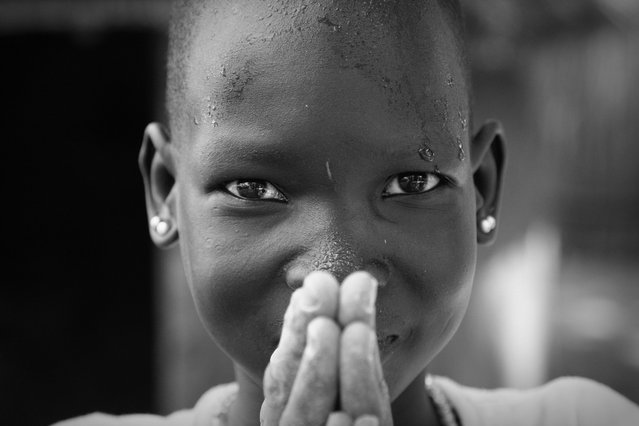
“Dusty Hands: Aluong lives in Duk Payuel, a small village in South Sudan. The dust on her hands is from shoveling maize from one bag provided by WFP, into another to take for her family. Her mother has been diagnosed with Tuberculosis. As part of a feeding program the family receives a small amount of food to supplement the temporary loss of a care giver. In between cupped hands full of maize, as sweat grew on her forehead, Aluong looked at me cheekily with her hands pressed together. In the face of such challenges for her family, the spirit of determination and excitement still flashed in her eyes”. (Photo and comment by Kristopher Schmitz/National Geographic Photo Contest via The Atlantic)
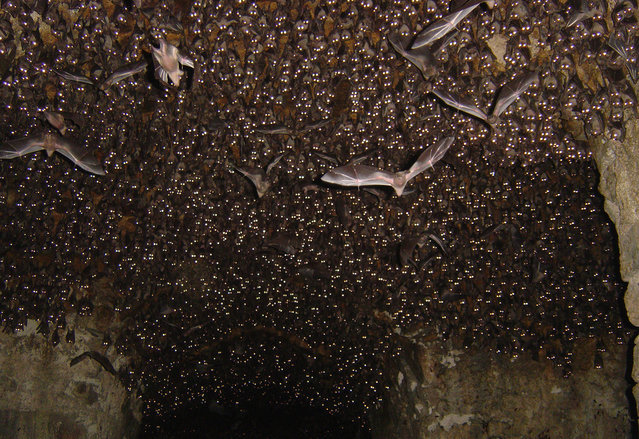
“Bats at Golconda Fort: This is the third shot with a flash, waking all of the bats up and seeing them all stare at the camera”. (Photo and comment by Bill Thoet/National Geographic Photo Contest via The Atlantic)
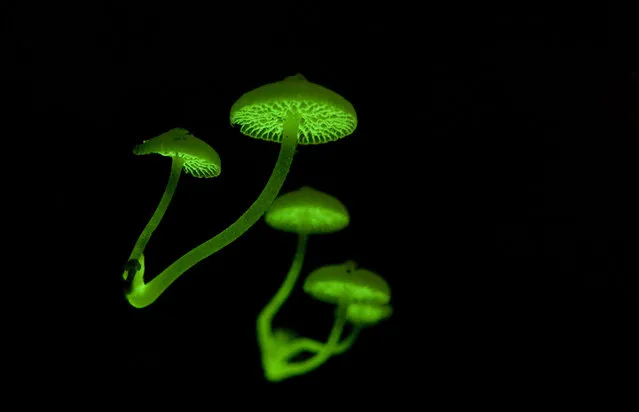
“Freaky Fungi: Hiking in pitch darkness within the dense forest undergrowth, one might encounter one of mother nature's awesome creations. A scene which many thought only belongs to the Sci-fi Movies. Filoboletus Manipularis is a fungus which naturally produces a faint eerie glow in the night by a natural process known as bioluminescence, shown in this 3-minute long exposure of these elusive little mushrooms”. (Photo and comment by Zong Ye Quek/National Geographic Photo Contest via The Atlantic)
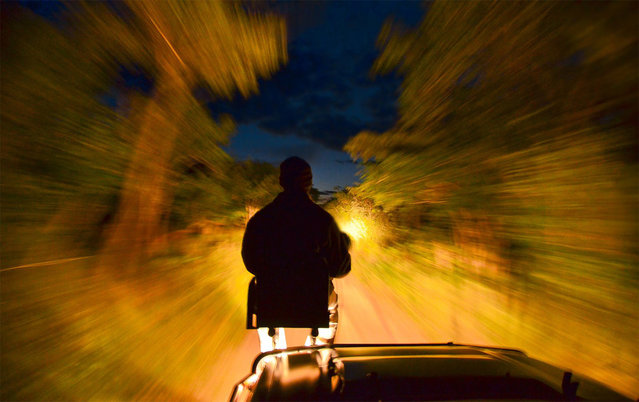
“Tunnel Vision: While on a night drive in the Sabi Sands game reserve in South Africa I decided to try something different, using the flood effect from the vehicles headlights and the motion from the trackers spotlight”. (Photo and comment by Bradley Leontsinis/National Geographic Photo Contest via The Atlantic)
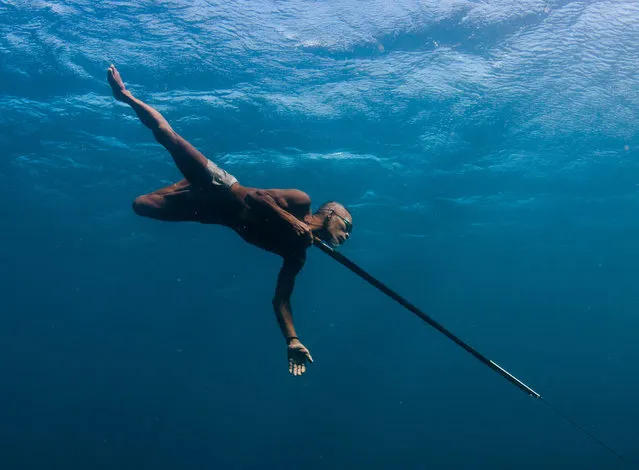
“80 Year Old Sea Gypsy Spear Fisherman: When he was young he remembers the Japanese passing through during WWII. He was a spear fisherman then, and still today at around 80 years old, he remains a spear fisherman. He earns little from his catch, maybe 2–3 dollars a day for spending hours in the water. This time in the water is keeping him young though, he is able to hold his breath for 2 minutes while chasing fish with no fins”. I could barely keep up with him and I had fins on. (Photo and comment by Caine Delacy/National Geographic Photo Contest via The Atlantic)
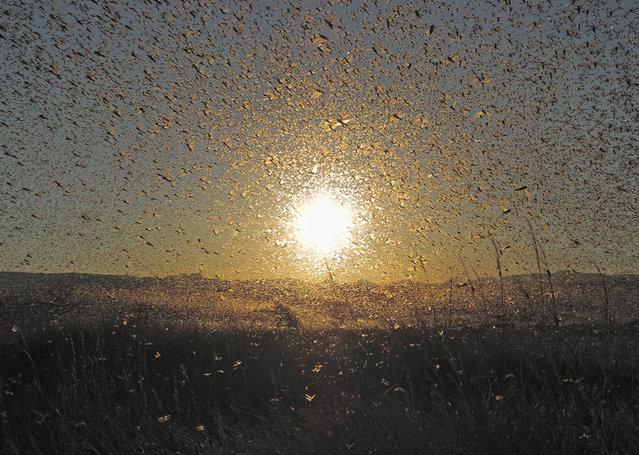
“Locusts: I've always wondered if a “plague of locusts” could block out the sun. They come close”. (Photo and comment by Anthony Mercer/National Geographic Photo Contest via The Atlantic)
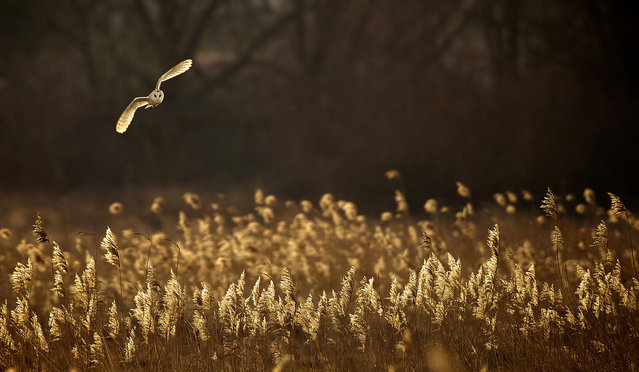
“Hunting at Dusk: A wild barn owl hunting over the Norfolk reeds, the evening light lit up the owl and the reeds to give them both the same colour and warmth”. (Photo and comment by Mark Bridger/National Geographic Photo Contest via The Atlantic)
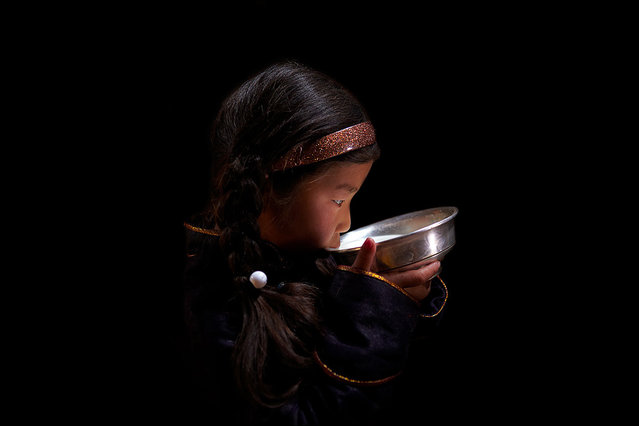
“Young Girl Drinking Mares Milk: Fermented mares milk (Airag) is the traditional national beverage of Mongolia. The amount of milk produced by one mare averages about two litres when milked six times per day, so in order to make enough Airag for the family and any visitors, it is necessary to have at least a dozen mares. To get good quality Airag, it is necessary to stir the milk mix no less than 1,000 times each day! Produced during the summer months in a specially made hide skin bag, fresh Airag is quite mild but if kept for long enough it turns sour and acidic which is how many Mongolian's prefer it”. (Photo and comment by Andrew Newey/National Geographic Photo Contest via The Atlantic)
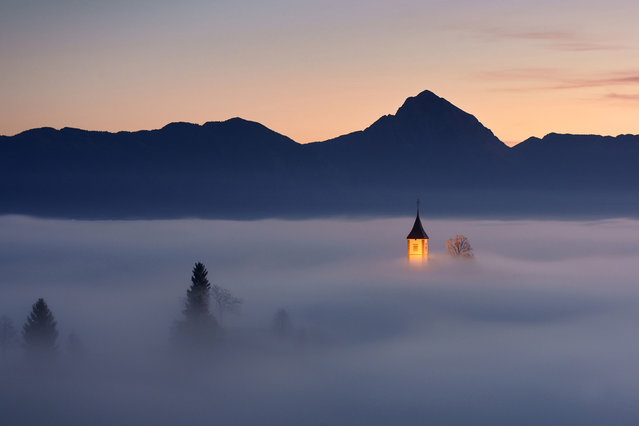
“Piece of Heaven: Jamnik, small village in Slovenia. One morning in in autumn, fog was just at the right height at the right time. The atmosphere was heavenly, unforgettable”. (Photo and comment by Janez Tolar/National Geographic Photo Contest via The Atlantic)
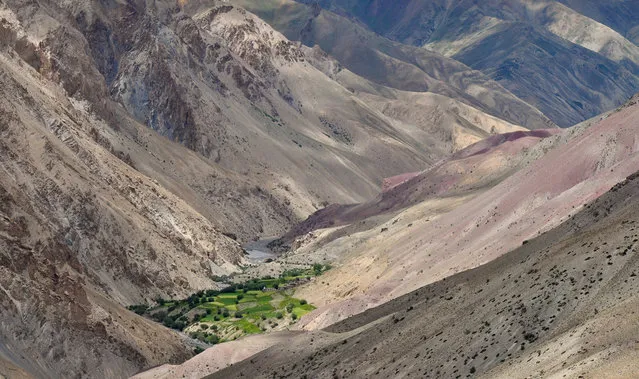
“Human Nest: High up in thin air, somewhere between Ladakh and Zanskar Himalayan range, among arid mountains of rocks, granite and sediments, some human beings manage to grow life”. (Photo and comment by Vincent Bonnin/National Geographic Photo Contest via The Atlantic)
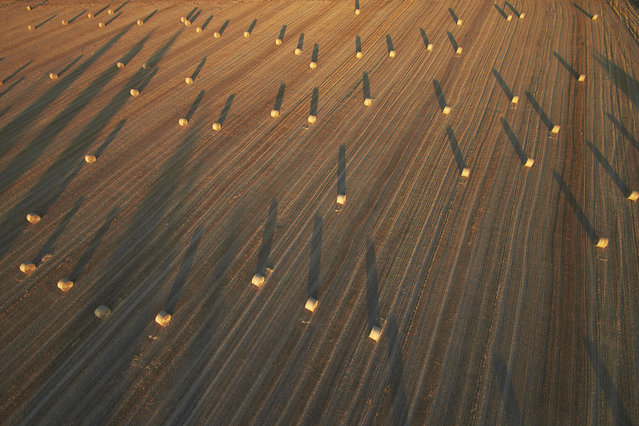
“Straw Meteors Field Forever: Thinking about perspectives that could make the difference, I mounted my reflex on an RC helicopter and shot at sunset above this field full of straw bales after the midsummer harvest”. (Photo and comment by Michel Giaccaglia/National Geographic Photo Contest via The Atlantic)
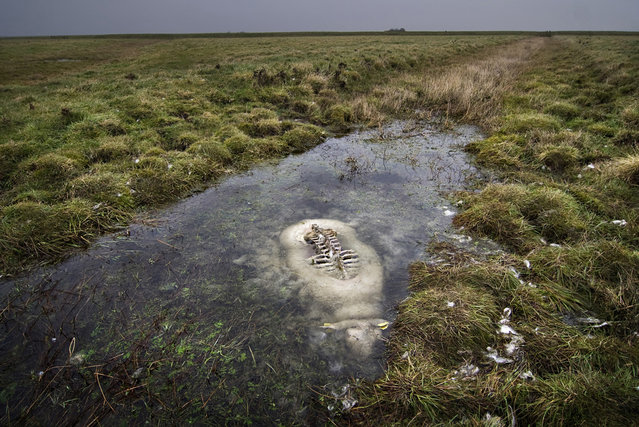
“Immersion: The sheep drowned while trying to cross a small canal in the meadow-swamp “Tøndermasken”, in southern Jylland in Denmark. Birds had eaten every part above the surface, and everything under was left totally untouched”. (Photo and comment by Johannes Bojesen/National Geographic Photo Contest via The Atlantic)
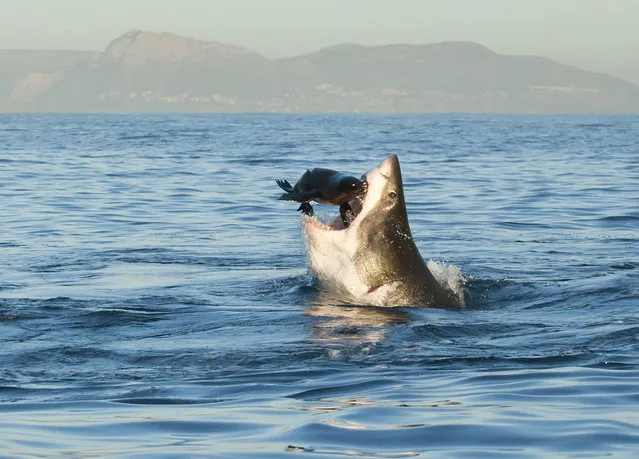
“The Great Escape: During a lovely morning in July I was out photographing Great White Sharks in False Bay, South Africa. We had two days when the sea was so still you could barely see a ripple”. (Photo and comment by Tonya Herron/National Geographic Photo Contest via The Atlantic)
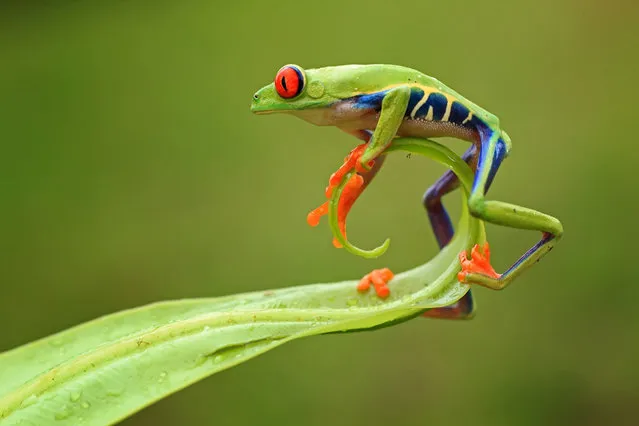
“Acrobatic: This small red eye frog playing at the edge of the leaf looks a bit like it's making some acrobatic move. It can blend well with the leaves, disguised from predators. Those big red eyes really caught my attention, drawing me to observe and photograph its moves”. (Photo and comment by Shikhei Goh/National Geographic Photo Contest via The Atlantic)
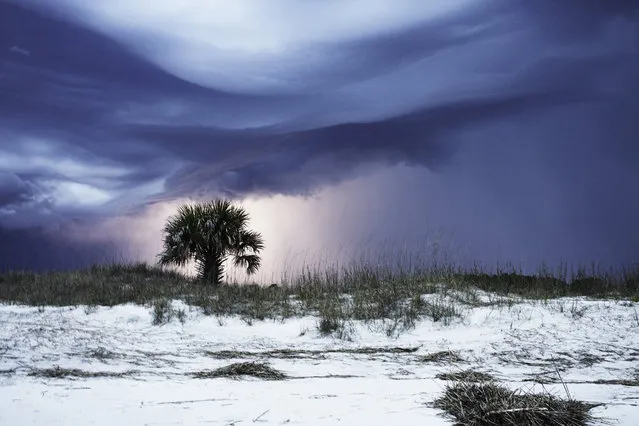
“Lightnng Storm: The coast in the midst of a storm”. (Photo and comment by Anna Ross/National Geographic Photo Contest via The Atlantic)
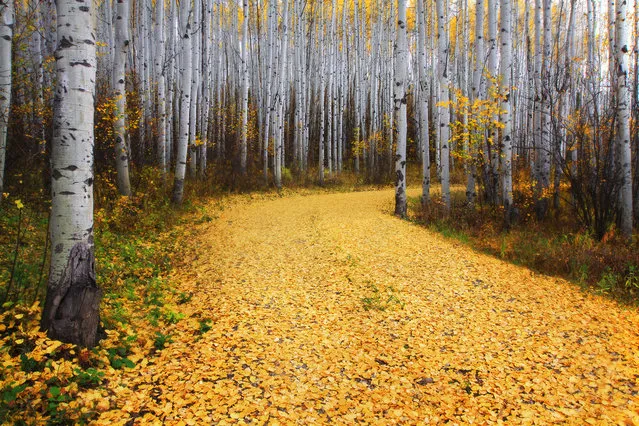
“Golden Road: A glorious road of gold through the aspen woods of Snowmass, Colorado”. (Photo and comment by Ron Azevedo/National Geographic Photo Contest via The Atlantic)
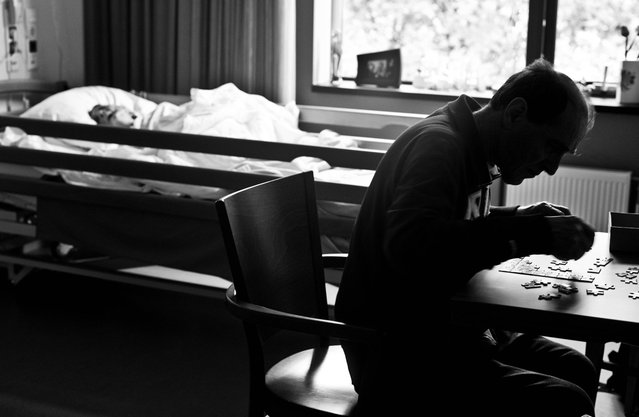
“A mentally handicapped man of 62, beside his dying 92 year old mother, on the last day of her life”. (Photo and comment by Eric Robben/National Geographic Photo Contest via The Atlantic)
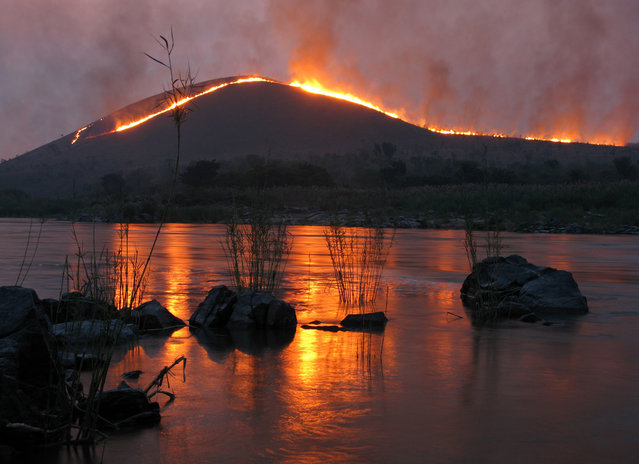
“The Congo River, deep in the Democratic Republic of Congo: Downstream from the infamous “Gates of Hell” rapids on the Congo river, this was the view from my camp during my five month canoe trip from source to sea. The grass covered hills were being burnt down for farming in the background”. (Photo and comment by Phil Harwood/National Geographic Photo Contest via The Atlantic)
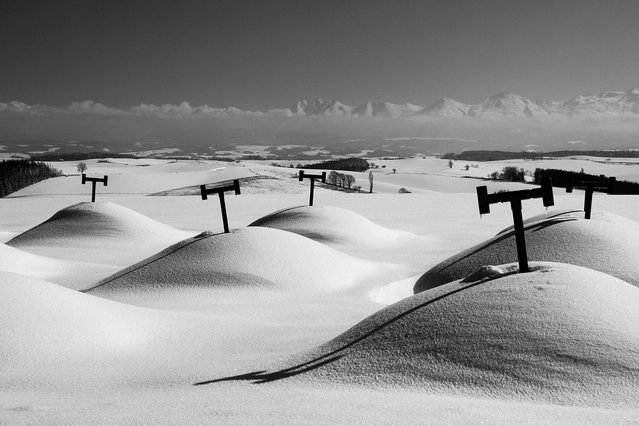
“Farmers' Wisdom: Farmers who live in Hokkaido invented this in their wisdom. Their potatoes, which pass the winter sleeping under snow, increase their sugar content. The part which remains visible here is a t-shaped pipe for releasing gas emitted by the potatoes”. (Photo and comment by Kent Shiraishi/National Geographic Photo Contest via The Atlantic)

“Gelada Charge: Easily identified by their “bleeding hearts”, Gelada baboons are endemic to the Ethiopian highlands and can be found in large troops foraging the grasslands of the Simien Mountains. Here, a group of three young males had infiltrated a group of females and begun grooming them. On detecting this intrusion the alpha male charged the interlopers, reasserting his dominance over them and protecting his harem”. (Photo and comment by Thomas Alexander/National Geographic Photo Contest via The Atlantic)
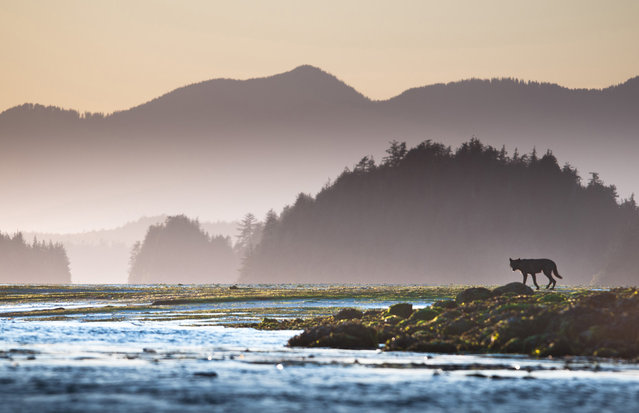
“Pacific Northwest Black Wolf: A black wolf on the mudflats off Meares Island in Clayoquot Sound UNESCO Biosphere Reserve on the remote west coast of Vancouver Island. The photo was taken shortly before sunset from a sea kayak”. (Photo and comment by Sander Jain/National Geographic Photo Contest via The Atlantic)
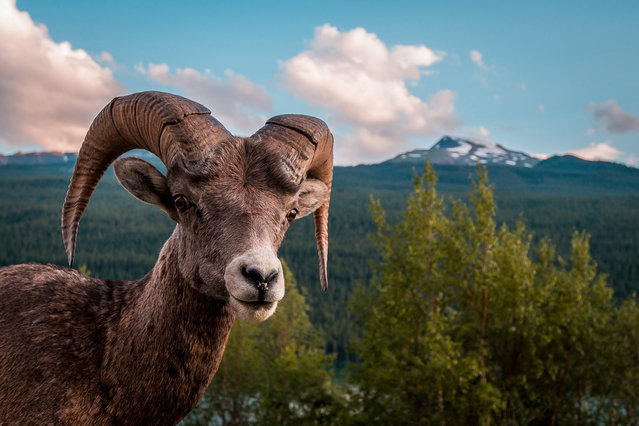
“Bold Ram: This rocky mountain big horn sheep ram was bold enough to allow me to approach him and snap this shot before he lost interest in me and rejoined his herd”. (Photo and comment by Scott Trageser/National Geographic Photo Contest via The Atlantic)
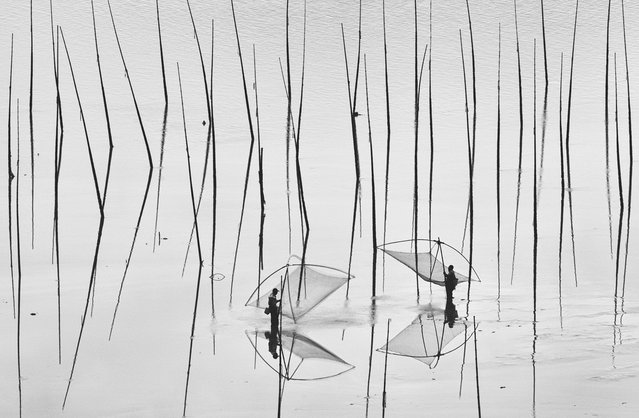
“Two Fishermen: The shoal is one of the most fascinating places in Xiapu, China. Fishermen farm fish, shrimp, and oysters and plant seaweed along this coast area”. (Photo and comment by Peng Jiang/National Geographic Photo Contest via The Atlantic)
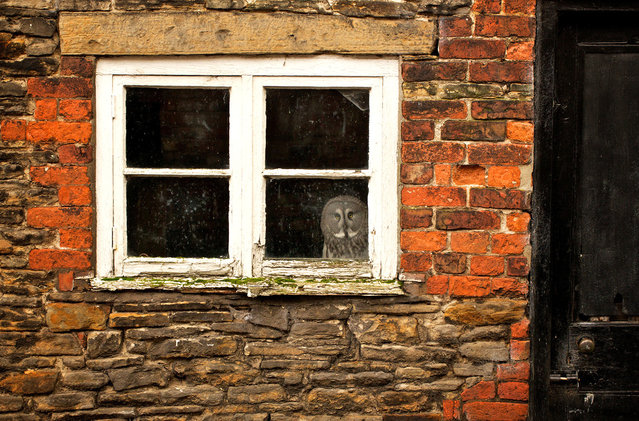
“I Like My House! This is Gandalf the Great Grey Owl and he gets scared flying out in the open so his owners have built his aviary inside a brick shed. He now loves spending his days watching the world go by out of his window”. (Photo and comment by Mark Bridger/National Geographic Photo Contest via The Atlantic)
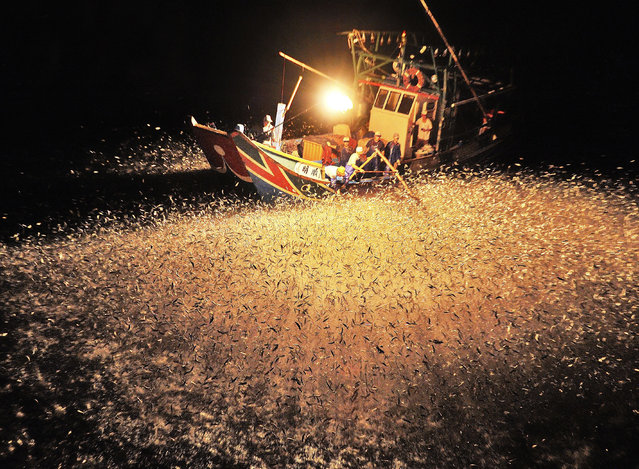
“The fishers catched fish in the night.They use the fire that made fish close the boat and got them”. (Photo and comment by Chang Ming Chih/National Geographic Photo Contest via The Atlantic)
05 Dec 2012 11:07:00,
post received
0 comments
